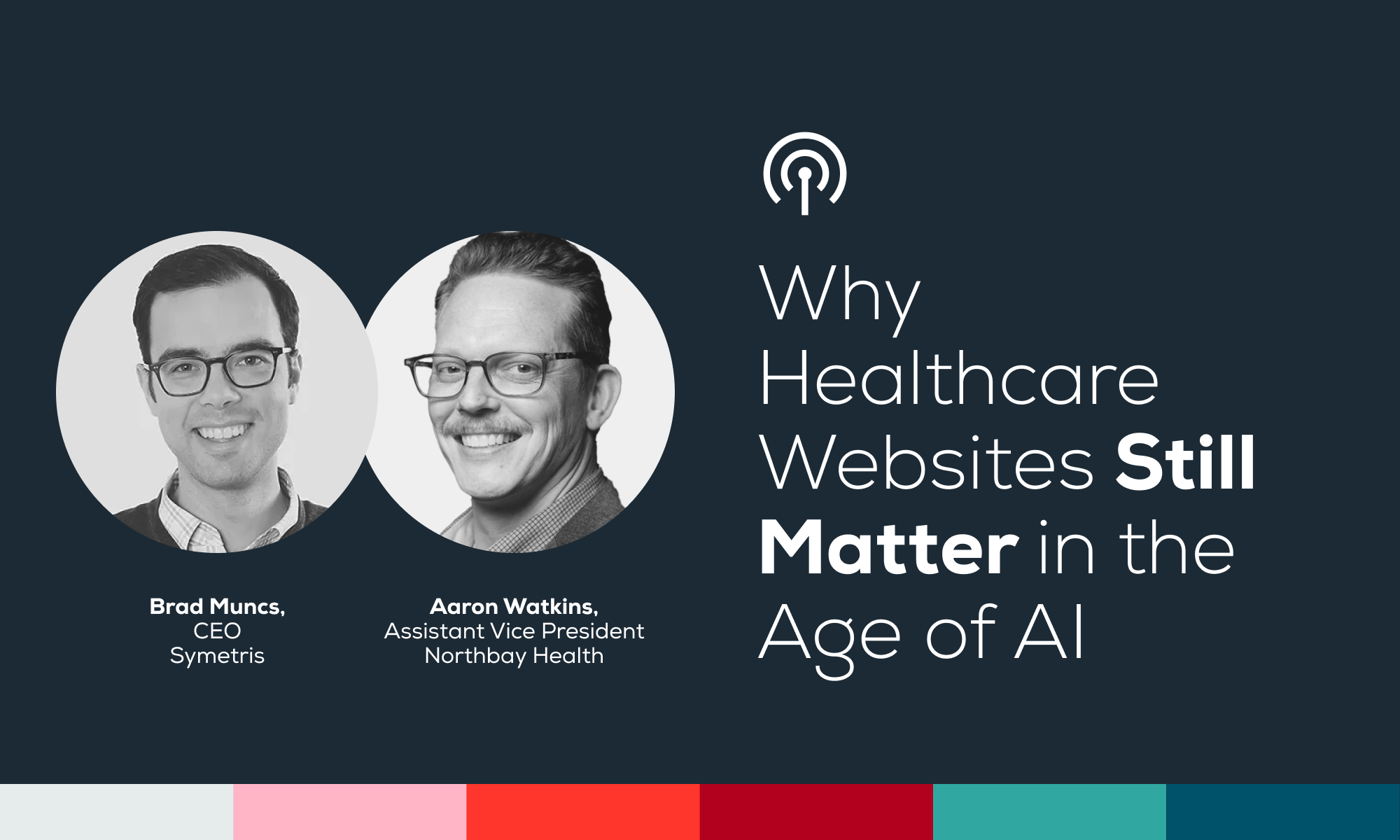Why Healthcare Websites Still Matter in the Age of AI
Web traffic is down, but value is up. Learn how to transform your healthcare website into a high-conversion, AI-ready tool for patient engagement.

Featuring insights from Aaron Watkins, Assistant Vice President, Digital Strategy for Northbay Health
The “web is dead” talk is getting loud. But it’s wrong.
The digital healthcare marketing landscape is shifting. AI tools are answering more patient questions directly. Organic website traffic is declining. Telehealth platforms are gaining ground.
Does that mean healthcare provider websites are losing relevance?
Not even close.
They’re not dying—they’re evolving. And for health systems, this evolution is a critical opportunity.
I recently sat down with Aaron Watkins, a healthcare digital marketing strategist (currently Assistant Vice President, Digital Strategy for Northbay Health, and previously spent 17 years at Johns Hopkins Medicine as Executive Director of Digital Strategy) to address the current website anxiety and where provider websites are headed in 2025.
One thing’s clear: Websites are still essential, but only if they’re treated as transactional tools, not static brochures.
Why Traffic to Healthcare Websites Is Dropping—And Why That’s Not the Real Problem
Content traffic is down, but patient trust is still high
If your organic traffic is falling, you’re not imagining it. As Google and AI tools answer more health questions directly, patients are clicking less. According to The Economist, Healthcare websites are receiving 31% less clicks compared to 12 months ago. But that doesn’t mean your content has lost its value.
“People always have questions that need to be answered. Do you need that basic brain tumor definition? Probably not. But do you need the content that talks about how you're unique and how you approach it? Yeah.
— Aaron Watkins
Generic condition overviews are becoming commoditized. What still drives value is content that reflects your voice: how your physicians practice, how your system delivers care, and what makes it different from the provider down the street.
Instead of volume, what matters now is content that's:
- Specific to your care organization’s philosophy, services, and team
- Trust-building, rooted in your brand and community presence
- Actionable, helping patients make informed decisions and convert (ex: find out if your insurance is accepted here)
Your site still plays a crucial role when patients are ready to act.
Your Website Is Still Your Best Patient Acquisition Tool
From Patient Education to Patient Action: The Role of Healthcare Websites in 2025
Healthcare websites used to be about education. Now they’re about transactions. Patients aren't just browsing; they're trying to book, pay, message, or find something specific.
“The foundation of web strategy going forward is really about physicians, services, locations.”
— Aaron Watkins
That doesn’t mean content is irrelevant, but priorities have shifted. If your site isn’t optimized for core transactions, then it’s out of step with what patients expect from every other digital experience in their lives.
To stay relevant:
- Lead with calls to action, not explanations
- Ex: Replace the vague "Learn More About Our Health System" in your hero banner with "Book an appointment" or "Find a Doctor"
- Reduce friction across transactional workflows
- Ex: Allow people to start filling out the booking form without asking them to create an account
- Measure success by completed tasks, not pageviews
- Ex: Focus on bottom of the funnel metrics like: "CTA Click" => Form filled out => "Get to the confirmation screen"
AI, Schema, and Structured Data: What Healthcare Marketers Must Prioritize
Search engines and AI don’t care how pretty your website is. They rely on structured, machine-readable data to surface relevant information in rich results and summaries.
That's why it's critical to:
- Use schema.org markup for physicians, services, and locations
- Good semantic HTML structure (H1, H2, alt text, etc)
- Keep directories accurate, indexable, and up-to-date
- Enrich profiles with real content: bios, photos, "why choose us" stories
These tactics are the building blocks your SEO and AEO strategy
What Marketers Should Focus on Now
Redefine your value proposition
Search engines and AI flatten everything. Your hospital, the one down the road, and the telehealth app all show up in the same blue links or answer boxes. That’s not where brand lives.
Your website is.
As generative search pulls users upstream, the ones who do visit are closer to choosing a provider or booking a service. That’s why volume matters less than what those users do once they arrive.
“You’re not driving all traffic—you’re driving actionable traffic.”
— Brad Muncs
Brand, trust, and value aren’t established in AI summaries. They’re earned where you control the experience.
Your job now:
- Focus on converting intent, not just capturing attention
- Build personalization into the journey where it matters
- Use your site to differentiate, not just inform
- Make completing tasks as easy as possible
Reframe the conversation with leadership
Frequent executive turnover isn’t just frustrating—it kills momentum. A redesign stalls. A content strategy resets. A personalization project loses its champion.
“One of the major challenges right now is the level and frequency of executive turnover across healthcare. That’s probably the biggest threat to the future of any health system’s web platform.”
— Aaron Watkins
Digital marketers need to make the case that the website is more than a marketing tool. It’s an operational asset.
To do that:
- Tie site performance to business outcomes (access, bookings, referrals, hiring)
- Talk about organizational objectives, not about campaign specifics
- Stick to your long-term strategy, even through leadership churn
The Real Opportunity: Focused, Strategic Websites for a New Era
Your website may not be the first touchpoint anymore. But it’s still the most important one when it comes time to act.
Your website is where your brand differentiates. Where your physicians are searchable. Where your services are bookable. And where your patients decide whether your system fits their needs or whether they should look elsewhere.
This isn’t the collapse of digital strategy. It’s the compression of it. The stakes are higher. The visits are more meaningful. And the experience has to deliver.
I’m grateful to Aaron Watkins for sharing his perspective in our recent conversation. We both firmly believe that healthcare websites aren’t fading into irrelevance: they’re just evolving into more focused, more strategic tools. And as marketers, we’re in the right position to lead that shift.
Healthcare marketers have adapted through SEO shifts, device revolutions, and pandemic surges. This is just another evolution. And you’re more ready than you think.
